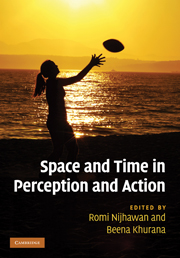Book contents
- Frontmatter
- Contents
- List of contributors
- Acknowledgments
- 1 Space and time: the fabric of thought and reality
- Part I Time–space during action: perisaccadic mislocalization and reaching
- Part II Temporal phenomena: perception
- Part III Temporal phenomena: binding and asynchrony
- Part IV Spatial phenomena: forward shift effects
- Part V Space–time and awareness
- 28 Object updating: a force for perceptual continuity and scene stability in human vision
- 29 A motion illusion reveals the temporally discrete nature of visual awareness
- 30 Priming and retouch in flash-lag and other phenomena of the streaming perceptual input
- Index
- References
29 - A motion illusion reveals the temporally discrete nature of visual awareness
from Part V - Space–time and awareness
Published online by Cambridge University Press: 05 October 2010
- Frontmatter
- Contents
- List of contributors
- Acknowledgments
- 1 Space and time: the fabric of thought and reality
- Part I Time–space during action: perisaccadic mislocalization and reaching
- Part II Temporal phenomena: perception
- Part III Temporal phenomena: binding and asynchrony
- Part IV Spatial phenomena: forward shift effects
- Part V Space–time and awareness
- 28 Object updating: a force for perceptual continuity and scene stability in human vision
- 29 A motion illusion reveals the temporally discrete nature of visual awareness
- 30 Priming and retouch in flash-lag and other phenomena of the streaming perceptual input
- Index
- References
Summary
Summary
Quasi-periodic or “discrete” brain processes are, in theory, susceptible to a phenomenon known in engineering as “temporal aliasing.” When the rate of occurrence of events in the world is fast enough, the perceived direction of these events may be reversed. We have recently demonstrated that, because of a quasi-periodic attentional capture of motion information, continuously moving objects are sometimes perceived to move in the wrong direction (the “continuous Wagon Wheel Illusion”). Using a simple Fourier energy model of motion perception, we established that this type of attentional capture occurs at a rate of about 13 Hz. We verified with EEG recordings that the electrophysiological correlates of this illusion are restricted to a specific frequency band around 13 Hz, over right parietal regions – known for their involvement in directing attention to temporal events. We summarize these results and discuss their implications for visual attention and awareness.
Introduction
With respect to the temporal organization of visual perception – the topic of this book – one important issue that has puzzled scientists for more than a century (James 1890; Pitts & McCulloch 1947; Stroud 1956; White 1963; Shallice 1964; Harter 1967; Varela et al. 1981; Purves et al. 1996; Crick & Koch 2003; VanRullen & Koch 2003) is whether our experience relies on a continuous sampling or a discrete sequence of periodic “snapshots” or “perceptual frames” of the external world. Although it may seem that such radically different mechanisms should be easy to distinguish using elementary introspection, the realism of the cinema serves to remind us that these two alternatives can in fact lead to equivalent perceptual outcomes.
- Type
- Chapter
- Information
- Space and Time in Perception and Action , pp. 521 - 535Publisher: Cambridge University PressPrint publication year: 2010
References
- 6
- Cited by



